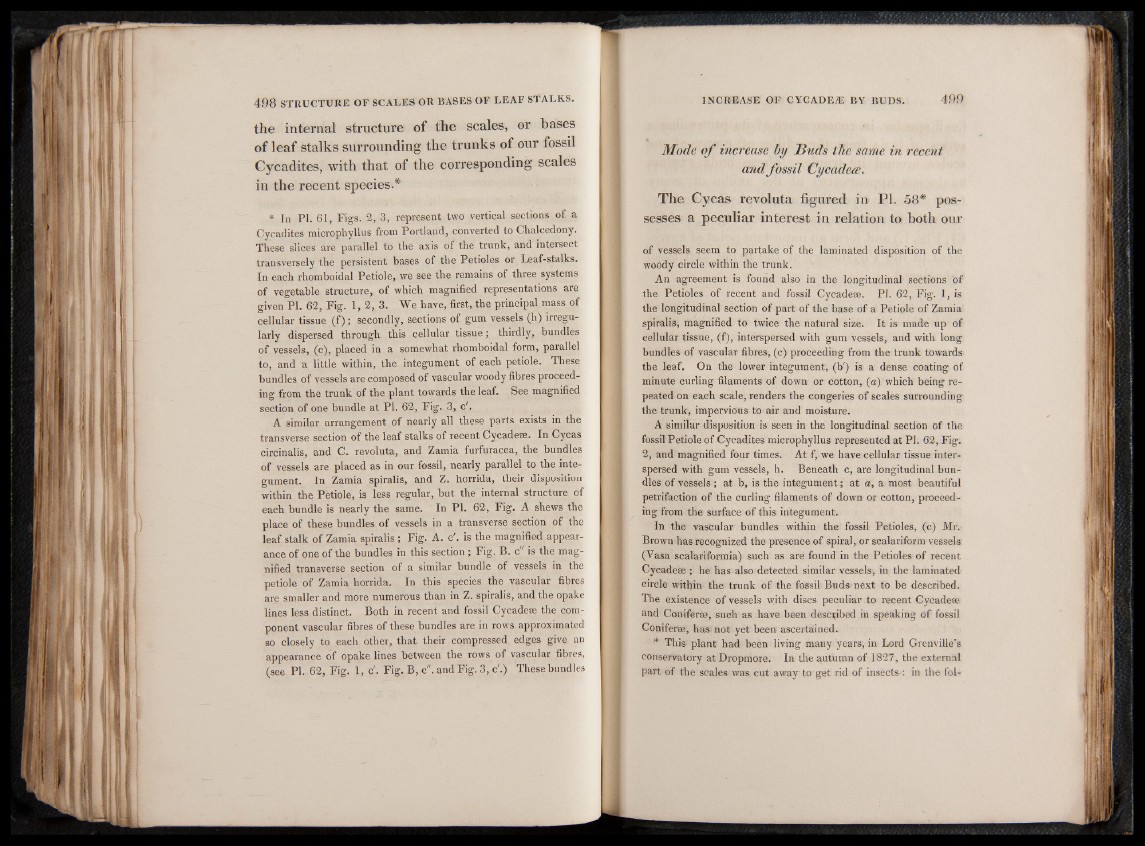
the internal structure of the scales, or bases
of leaf stalks surrounding the trunks of our fossil
Cycadites, with that of the corresponding scales
in the recent species.*
* In PI. 61, Figs. 2, 3, represent two vertical sections of a
Cycadites microphyllus from Portland, converted to Chalcedony.
These slices are parallel to the axis of the trunk, and intersect
transversely the persistent bases of the Petioles or Leaf-stalks.
In each rhomboidal Petiole, we see the remains of three systems
of vegetable structure, of which magnified representations are
given PI. 62, Fig. 1, 2, 3. We have, first, the principal mass of
cellular tissue ( f ) ; secondly, sections of gum vessels (h) irregularly
dispersed through this cellular tissue; thirdly, bundles
of vessels, (c), placed in a somewhat rhomboidal form, parallel
to, and a little within, the integument of each petiole. These
bundles of vessels are composed of vascular woody fibres proceeding
from the trunk of the plant towards the leaf. See magnified
section of one bundle at PI. 62, Fig. 3, c'.
A similar arrangement of nearly all these parts exists in the
transverse section of the leaf stalks of recent Cycadese. In Cycas
circinalis, and C. revoluta, and Zamia furfuracea, the bundles
of vessels are placed as in our fossil, nearly parallel to the integument.
In Zamia spiralis, and Z. horrida, their disposition
within the Petiole, is less regular, but the internal structure of
each bundle is nearly the same. In PI. 62, Fig. A shews the
place of these bundles of vessels in a transverse section of the
leaf stalk of Zamia spiralis ; Fig. A. c'. is the magnified appearance
of one of the bundles in this section ; Fig. B. c" is the magnified
transverse section of a similar bundle of vessels in the
petiole of Zamia horrida. In this species the vascular fibres
are smaller and more numerous than in Z. spiralis, and the opake
lines less distinct. Both in recent and fossil Cycadese the component
vascular fibres of these bundles are in rows approximated
so closely to each other, that their compressed edges give an
appearance of opake lines between the rows of vascular fibres,
(see PI. 62, Fig. 1, c'. Fig. B, c". and Fig. 3, c'.) These bundles
499
Mode o f increase by Muds tile same in recent
and fossil Cycadece.
The. Cycas revoluta figured in PI. 58* possesses
a peculiar interest in relation to both our
of vessels seem to partake of the laminated disposition of the
woody circle within the trunk.
An agreement is found also in the longitudinal sections of
the Petioles of recent and fossil Cycadese. PI. 62, Fig. I, is
the longitudinal section of part of the base of a Petiole of Zamia
spiralis, magnified to twice the natural size. It is made up of
cellular tissue, (f), interspersed with gum vessels, and with long
bundles of vascular fibres, (c) proceeding from the trunk towards
the leaf. On the lower integument, (b') is a dense coating of
minute curling filaments of down or cotton, (a) which being repeated
on each scale, renders the congeries of scales surrounding
the trunk, impervious to air and moisture.
A similar disposition is seen in the longitudinal section of the
fossil Petiole of Cycadites microphyllus represented at PI. 62, Fig.
2, and magnified four times. At f, we have cellular tissue interspersed
with gum vessels, h. Beneath c, are longitudinal bundles
of vessels ; at b, is the integument; at a, a most beautiful
petrifaction of the curling filaments of down or cotton, proceeding
from the surface of this integument.
In the vascular bundles within the fossil Petioles, (c) Mr.
Brown has recognized the presence of spiral, or scalariform vessels
(Vasa scalariformia) such as are found in the Petioles of recent
Cycadese ; he has also detected similar vessels, in the laminated
circle within the trunk of the fossil Buds next to be described.
The existence of vessels with discs peculiar to recent Cycadese
and Coniferse, such as have been described in speaking of fossil
Coniferae, has not yet been ascertained.
* This plant had been living many years, in Lord Grenville’s
conservatory at Dropmore. In the autumn of 1827, the external
part of the scales was cut away to get rid of insects : in the fol